|
Cybersecurity and Infrastructure Security Agency’s Office for Bombing Prevention Bulletin Issue #11
In This Issue
- CISA OBP Recognizes Critical Infrastructure Security and Resilience Month
- Experts Gather to Explore the Challenges in Combatting Terrorist Use of Explosives
- Bombing Prevention Community Saddles Up to Collaborate on Emerging Technologies at the National Robot Rodeo
- CISA OBP Empowered Trainer Program Reaches Milestone
- CISA OBP Launches Comprehensive Bomb Threat Guide
- CISA OBP Discusses Bomb Threat Mitigation at the 2023 Washington, D.C., Interoperability Summit
- CISA OBP Works with Partners to Enhance Integrated Capstone Event
- CISA OBP Co-Hosts the 2023 National Bomb Squad Commander’s Conference
- Chemical Facility Anti-Terrorism Standards Program Lapse
- CISA OBP Collaborates with FEMA for Before, During, and After Podcast
- Region 4 Briefs Explosive Experts at FBI School
The Cybersecurity and Infrastructure Security Agency (CISA) Office for Bombing Prevention (OBP) Bulletin features a range of news stories, data, training information and resources from CISA OBP. In an effort to create a secure and resilient nation free from the fear and effects of bombings, CISA OBP leads the Department of Homeland Security’s (DHS) efforts to implement the National Policy for Countering Improvised Explosive Devices (C-IED) and enhances national security by building public and private capabilities to deter, prevent, and respond to bombing incidents.
*CISA does not endorse any product, service or enterprise. Information in this document is provided as a convenience and for informational purposes only; it does not constitute an endorsement or an approval by CISA of any of products, services or opinions of any corporation, company, organization or individual. CISA bears no responsibility for the accuracy, legality, or content of any external site or for that of subsequent links.
Policy
CISA OBP Recognizes Critical Infrastructure Security and Resilience Month

With an evolving threat landscape, infrastructure security remains a priority at all levels of government and the private sector. November serves as Critical Infrastructure Security and Resilience Month, and CISA highlighted how critical infrastructure stakeholders can “Resolve to be Resilient” through proper planning. November’s resiliency campaign focused on integrating processes and practices into a response plan that anticipates disruption to infrastructure and reduces recovery time.
Some keys to safeguarding our infrastructure include preventing, protecting against, responding to and mitigating the use of explosives against both public and private sectors, which is the mission of CISA OBP. According to the 2022 Explosives Incident Report (EIR), a joint product between CISA and the United States Bomb Data Center, 2,538 bomb threats were reported in 2022—a 35% increase from 2021. The EIR also revealed a 23% increase in explosion incidents between the two years (from 785 to 966).
As part of November’s designation, CISA OBP engaged with stakeholders nationwide on the impact of bombing incidents and threats to critical infrastructure. This effort included providing training and resources to reduce the risk of an attack. CISA OBP’s approach improves capabilities to protect critical infrastructure, which spans the healthcare sector, water systems, and education facilities to the chemical sector, transportation systems, energy and more. To learn more about the different critical infrastructure sectors, visit Critical Infrastructure Sectors | CISA.
CISA OBP’s Associate Director (AD) Sean Haglund reminds us, “Part of our society’s collective benefit is the protection and resiliency of critical infrastructure. While we cannot guarantee that an attack will never take place, we can work to minimize the potential impact through proper planning and coordination.” He adds, “Mitigating risk to our nation’s infrastructure is a fundamental component of national security, and we thank all of our partners for their efforts in its protection.”
To learn more about CISA’s November activities highlighting Critical Infrastructure Security and Resilience Month, check out the Critical Infrastructure Security and Resilience Month Toolkit | CISA. For more on CISA OBP, including access to free training, awareness products and more about OBP’s mission, visit Office for Bombing Prevention | CISA.
|
Experts Gather to Explore the Challenges in Combatting Terrorist Use of Explosives
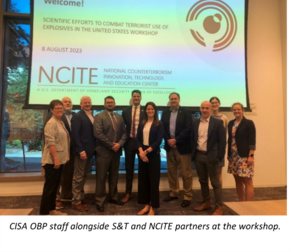
Late last summer, CISA OBP joined a select group of national leaders and IED experts for a collaborative workshop led by the National Counterterrorism Innovation, Technology and Education Center (NCITE).
NCITE hosted the workshop to update the 2008 report, “Research Challenges in Combating Terrorist Use of Explosives in the United States,” at the American Geophysical Union in Washington, D.C. The event identified operational challenges and knowledge gaps facing the C-IED mission community.
CISA OBP Strategy Deputy Branch Chief Jason Stewart and Dana Saft, Technical Program Manager from the DHS Science and Technology Directorate (S&T), supported the project, which examines changes in the C-IED research and development landscape since the previous report’s publication in 2008. The research team is led by NCITE head of counterterrorism research initiatives, Austin Doctor, Ph.D., Sam Hunter, Ph.D., and Gina Ligon, Ph.D.
Based at the University of Nebraska at Omaha, NCITE is funded by DHS as a Center of Excellence focused on counterterrorism and targeted violence prevention. Stewart noted, “CISA OBP looks forward to continued collaboration with S&T and NCITE as they conclude the update to the 2008 report.”
To access the 2008 report, please visit here.
For more information about CISA, including access to awareness products, training opportunities or other resources visit Office for Bombing Prevention | CISA.
|
Outreach & Training
Bombing Prevention Community Saddles Up to Collaborate on Emerging Technologies at the National Robot Rodeo
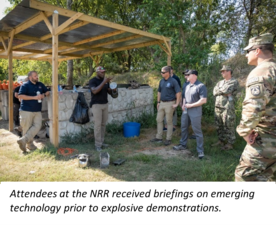
Representatives from DHS, CISA OBP, U.S. Bomb Technician Association, U.S. Naval Surface Warfare Center, U.S. Air Force Civil Engineer Center, Sandia National Laboratory, United Kingdom Defense Science and Technology Laboratory, and other public and private sector stakeholders and partners saddled up and rode into the National Robot Rodeo (NRR) in Humble, Tex., in July.
This multi-day event highlights robotics technology in urban scenarios designed to replicate commonly encountered domestic threats. Specifically, it simulates IEDs and vehicle-based IED disablement, tactics, techniques and procedures; and supports security for the transportation sector. With the recent rise in bomb threats, the use of advanced robotics has grown significantly. The NRR exposed experienced military and public safety bomb squad technicians to new products and emerging technology. It offered the technicians an opportunity to test the equipment under simulated conditions and provide real-time feedback to event facilitators, sponsors and supporting vendors.
|

Each year, CISA OBP builds upon its partnerships to introduce stakeholders to the latest products and technology. Several representatives participated in the various demos, including CISA’s Infrastructure Security Division (ISD) Deputy Executive Assistant Director (EAD) Steve Harris and CISA OBP’s Deputy AD Dave Williamson. “The National Robot Rodeo provides an excellent opportunity for participants from multiple agencies to network and exchange information on tactics, techniques and procedures. The event advances EOD and bomb technician training and technology to ensure consistency and best practices around the nation,” Williamson noted.
For more information about awareness products, training opportunities or other resources visit Office for Bombing Prevention | CISA. For more on the National Robot Rodeo, visit 2023 Eastern National Robot Rodeo.
|
CISA OBP Empowered Trainer Program Reaches Milestone

During the summer, the Las Vegas Fire and Rescue Bomb Squad delivered the Bombing Prevention Awareness course, which marked the 500th course delivered under the Empowered Trainer Program. This course provided local security personnel and stakeholders with an overview of IEDs and explosive effects, an introduction to the terrorist attack cycle, and an introduction to appropriate responses to suspicious behaviors and items.
CISA OBP established the Empowered Trainer Program to build the C-IED capabilities of public and private stakeholders. This program equips local trainers with the expertise to effectively deliver training within their jurisdictions and organizations using accredited curricula and learning management systems. CISA OBP leverages these pre-certified trainers to deliver CISA OBP training courses through a train-the-trainer model. Empowered Trainers represent federal agencies, law enforcement, first responder, emergency management and private sector security communities. The trainers are passionate about teaching and are dedicated to increasing safety and security in their communities and organizations.
The Empowered Trainer Program exponentially expands CISA OBP’s efforts to protect, prevent, mitigate and respond to bombing and terrorist incidents that target critical infrastructure. CISA OBP recognizes the training provided by Empowered Trainers as a vital component of national preparedness.
For more information on CISA’s OBP Empowered Trainer Program, please visit Bombing Prevention Training | CISA or email us at OBPTraining@cisa.dhs.gov.
|
CISA OBP Launches Comprehensive Bomb Threat Guide
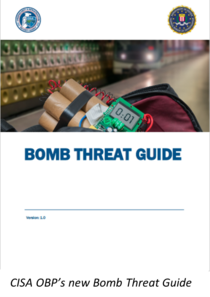 |
|
As the threat landscape evolves, preventative measures must respond in kind to address it. CISA OBP’s latest Bomb Threat Guide will help organizations revise or develop a bomb threat response plan and contingencies in the event an explosive device is involved.
Specifically, this version expands on previous guidance by providing additional information that will contribute to an orderly and controlled response to a bomb threat. Bomb threats can severely impact organizations and personnel regardless of the perpetrator’s intent. Primary impacts such as operational and psychological can be witnessed immediately, however secondary impacts such as the financial implications may take time to fully realize. The guide helps minimize and mitigate these potential outcomes.
|

When it comes to IEDs and bomb threats, having a clear, specific and well-developed plan can save lives and protect critical infrastructure. Each bomb threat is unique and requires rapid evaluation to mitigate the immediate impact and manage in accordance with site needs. CISA OBP recommends owners and operators periodically review federal guidance (including this product) and collaborate with first responders to establish and rehearse a bomb threat management plan that addresses each risk level appropriate for their specific site location.
Highlights from the Bomb Threat Guide include:
- Planning and preparation sections
- Threat assessments
- Response options
- Suspicious items recognition
- Additional resources and training opportunities
Upon releasing the guide, CISA OBP’s Training Branch Chief Curt Tilley noted, “In 2022, the United States witnessed a 35% increase in bomb threats from the previous year. As such, it is more important than ever to remain vigilant in planning for these incidents to mitigate the impact on personnel and infrastructure.” He added, “This new product provides comprehensive planning solutions and resources that apply to every organization, and we highly recommend utilizing it to improve security postures.”
To access the Bomb Threat Guide and other training opportunities and resources, please visit Bombing Prevention | Training.
|
CISA OBP Discusses Bomb Threat Mitigation at the 2023 Washington, D.C., Interoperability Summit

CISA OBP spoke at the 5th Annual Washington, D.C., Interoperability Summit held at Gallaudet University. This Summit highlighted the 10th anniversary of the Boston Marathon Bombing and featured keynote speaker Ed Davis, the former Boston Police Commissioner who responded to the attacks.
In addition, CISA OBP’s AD Haglund provided opening remarks on “Explosive Threats and Mitigating Attacks.” He noted how CISA OBP supports the mission to prevent future bombing attacks and encouraged the approximately 625 attendees to take advantage of its products and services. CISA OBP also showcased options for in-person and online training and education, and various resources and programs, including Virtual Instructor-led Training, TRIPwire, Bomb-Making Materials Awareness Program and the Security Resilience Guide and Annexes.
AD Haglund said, “CISA OBP looks forward to future participation and collaboration with the DC Homeland Security and Emergency Management Agency and their 2024 Interoperability Summit.”
|
CISA OBP Works with Partners to Enhance Integrated Capstone Event
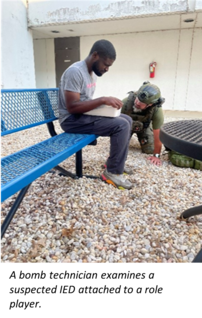
CISA OBP teamed up with the FEMA Center for Domestic Preparedness (CDP) and the National Bomb Squad Commander’s Advisory Board (NBSCAB) to support the addition of public safety bomb squads (PSBS) in CDP Integrated Capstone Events (ICE). The Georgia Bureau of Investigation Bomb Squad volunteered to participate in an event to test the concept.
An ICE event is a culmination exercise that includes first responders from various disciplines and follows the completion of their collective training evolutions at the CDP. Participants come from multiple disciplines, such as medical, HAZMAT, mobile field force, environmental health, radiological response and emergency management.
The intent of the ICE event is to demonstrate how each public safety component supports and compliments another under stress. Typical exercise scenarios include man-made or natural disasters, which require a collective multi-disciplined response and provide participants the opportunity to exercise the skills they have obtained at the CDP. ICE events conclude with an after-action review and individual debrief to identify each student’s performance strengths and weaknesses, and to validate the expected training results from the CDP. These events provide participants with vital individual and collective training in responding to, mitigating and preventing disaster incidents, including incidents involving IEDs and critical infrastructure. The feedback derived from these events directly inform future CDP and CISA OBP training requirements.
This exercise is designed around several “crisis response” scenarios that include IEDs requiring manual techniques to render safe. The exercise was carefully crafted, designed and developed to ensure that the tactics, techniques or procedures used best aligned with the FBI’s Hazardous Devices School training and the National Guidelines for Bomb Technicians logic tree. CISA OBP is encouraged by the outcome of this initiative and looks forward to working with our partners to improve these events and advocate for this unique opportunity across the PSBS community.
|
CISA OBP Co-Hosts the 2023 National Bomb Squad Commander’s Conference
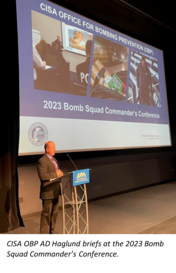
Last fall, CISA OBP partnered with the FBI’s Hazardous Devices School (HDS), the FBI’s C-IED Unit, the ATF’s National Center for Explosives Training and Research, and NBSCAB to host the National Bomb Squad Commander’s Conference at Redstone Arsenal in Huntsville, Ala.
The three-day conference, in September, included 341 public safety bomb squad commanders from across the country, alongside representatives from supporting federal agencies. CISA Deputy EAD Harris provided opening remarks along with his counterparts from the FBI and ATF. On Day One of the conference, attendees received briefings from key federal partners and professional organizations focused on information exchange and collaboration to better prepare for, protect against and mitigate an IED threat.
Day Two focused on a variety of topics, including:
- Demonstrations on special application explosives used in the entertainment industry
- Updates to the “National Guidelines for Bomb Technicians” and special program areas
- Key resources available from OBP, CDP and TSA
- Emerging C-IED threats and defeat technology
Day Three highlighted case studies from state and local bomb squad commanders. These briefings demonstrated the complexities of several unusual incidents handled by squads around the country, the lessons learned and how they might adjust their tactics in the future. The day culminated with a presentation by the Ukrainian National Police’s Bomb Squad Commander, who provided critical insight into the challenges that his unit faces because of the conflict with Russia. Several of the attending commanders commented that the case studies are quite valuable when developing training and operational plans.
To learn more about the latest explosive threats and trends, please visit TRIPwire.
|
Chemical Facility Anti-Terrorism Standards Program Lapse
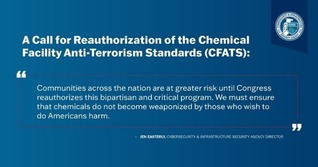
[Contribution by the Office of Chemical Security, a component of CISA’s Infrastructure Security Division]
For more than 15 years, the Chemical Facility Anti-Terrorism Standards (CFATS) program helped to protect communities against the terrorist exploitation of dangerous chemicals, including many explosive precursor chemicals. It has now been more than six months since authorization of the CFATS program was allowed to expire, and the American people have lost an essential program at a moment when the threat of chemical weaponization is as relevant as it has ever been.
Since CFATS expired, our nation, chemical facilities, first responders, and communities—including the 7,000 schools, colleges, and universities located within a mile of high-risk chemical facilities—have already been impacted. In the last six months:
- CISA has not received information on dangerous chemicals from more than 200 chemical facilities—meaning the locations of dangerous chemicals are unknown to CISA and local first responders.
- CISA cannot inspect high-risk sites—meaning that more than 1,000 chemical security inspections have been cancelled. Because more than a third of inspections turn up security gaps, there are likely hundreds of security gaps that CISA has been unable to identify and work with facilities to prevent bad actors from exploiting.
- CISA cannot require the implementation of cyber and physical security measures or assess the risk to these facilities and the communities that surround them. On average, facilities improve their security posture by nearly 60% to comply with CFATS. This means that hundreds of needed cyber and physical security measures have not been implemented to reduce the risk that dangerous chemicals are weaponized.
- CISA has not conducted terrorist vetting for around 60,000 personnel who have recently gained access to dangerous chemicals—that’s 9,000 names each month going unvetted.
When anti-terrorism regulatory programs function properly, it can be easy to underestimate the effects of their absence. We must not wait until an attack on a chemical facility shows us the consequences of letting CFATS expire. CISA urges Congress to act now to reauthorize this vital program.
|
CISA OBP Collaborates with FEMA for Before, During & After Podcast

To engage with a broad range of stakeholders across other entities, CISA OBP TAB’s Chief Darren Flick sat down with Mark Peterson, host of the Federal Emergency Management Agency’s (FEMA) Before, During & After podcast. The podcast is tailored to emergency managers and highlights the need for disaster preparedness and the importance of keeping communities safe from emerging threats.
During this segment, they discussed how both agencies educate the public and private sectors before, during and after natural or man-made disasters. Flick mentioned the opportunity for FEMA to utilize the wide range of CISA OBP courses, which cover from the basic 101-level of IEDs to some of the more complex courses on surveillance. These courses enable attendees to expand their knowledge and awareness of threats and the number of IED incidents occurring across the United States.
Peterson noted the training courses aren’t just about educating responders but can also be pivotal in building public participation in threat prevention before it leads to harm. Flick confirmed, “If you take a C-IED course, it’s going to help you across all your responses…It truly will build your response capability across all hazards.”
To listen to the podcast in its entirety, please visit here.
|
Region 4 Briefs Explosive Experts at FBI School
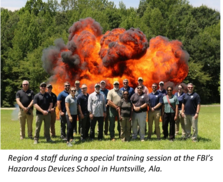
Sometimes staying left of a real boom literally means knowing about the services, tools and resources available to help keep businesses, organizations and individuals safe. That’s why CISA Region 4 staff in Mississippi and Alabama shared how the agency works to reduce risk to critical infrastructure during a special training session at the FBI’s Hazardous Devices School in Huntsville, Ala.
Led by Supervisory Chemical Security Inspector (SCSI) Robert “Bing” Crosby, the session provided federal agents specialized in explosives and weapons of mass destruction (WMDs) an in-depth look at several CISA programs, such as ChemLock and CISA OBP’s Operation Flashpoint, and discussed the functions of the Protective Security Advisors (PSAs), Cybersecurity Advisors (CSAs) and Chemical Security Inspectors (CSIs).
“This training was a first for Region 4,” said SCSI Crosby. “Having provided past similar explosives training and knowledge of precursor chemical and explosives to ATF agents, I knew there was a great opportunity to show the overlap between what we do at CISA and what they teach at the school.”
|

Part of the FBI’s Critical Incident Response Group, the Hazardous Devices School trains federal, state and local law enforcement officers to become certified public safety explosives technicians. Graduates of the program are required to take additional training for recertification every three years.
As part of the presentation, three members of Region 4’s field team—Mississippi’s CSI Rodney Knight, and Alabama’s PSA Shirrell Roberts and CSA Joe Parker—each gave an overview of their respective mission areas. Once the briefings concluded, the CISA team and other attendees had the opportunity to see a unique explosives demonstration using simulated homemade explosives made from precursor chemicals that can be found at many facilities that participate in the ChemLock program.
SCSI Crosby added, “Thanks to this training, CISA and Region 4 now have greater exposure with both the Hazardous Devices School and the WMD coordinators throughout the Southeast; and Region 4 now has an open invite to come back and bring more CSIs for training and hopefully a few more explosives demos!”
Regional Director Jay Gamble commended Crosby and the Mississippi and Alabama field teams for finding unique ways to help spread the word about Region 4 and how it can help explosives technicians reduce risk before the worst could happen.
“Explosives experts have a very dangerous job, and the information our team provided during this briefing can go a long way in helping these professionals keep the communities they serve safe,” Gamble said. “Thanks to Bing and the entire team for doing their part to help our federal partners always stay left of boom.”
|
Learn more about CISA's Office for Bombing Prevention
For more information about CISA OBP, visit Bombing Prevention | CISA or email
OBP@cisa.dhs.gov.
|